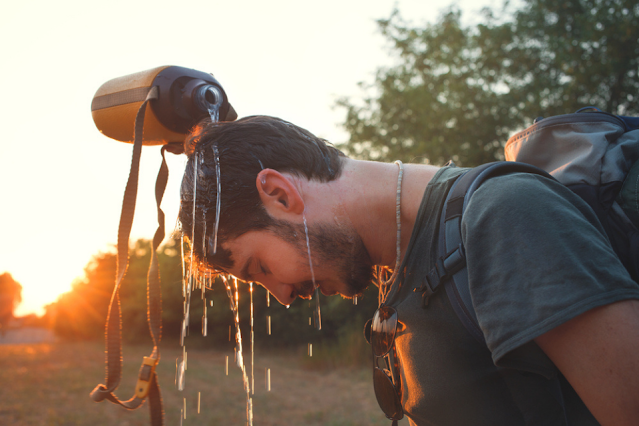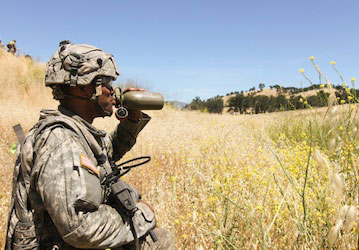When your body overheats during exercise, exertional heat illness can occur. Intense exercise in hot temperatures also can put you at risk of rhabdomyolysis (breakdown of muscle tissue) and other injuries. There are many factors that raise your risk of heat illness, but one way you can combat heat stress is with performance nutrition and hydration. When you choose the right fluids and fuel at the right times, your body is better equipped to handle exercise in the heat.
Your body under heat stress
During exercise, especially in hot environments, your body cools itself by sweating. Sweat is a mixture of fluid and electrolytes such as sodium, chloride, potassium, magnesium, and calcium. When sweat losses are high, such as during prolonged exercise in the heat, you risk becoming dehydrated. Dehydration negatively affects both physical and mental performance and puts you at higher risk of heat illness.
As you acclimatize to hot environments, your body becomes more efficient at cooling itself. You actually sweat more, but you’re able to reabsorb some of the electrolytes you lose in sweat. To maximize performance in the heat, it’s important to ensure you start exercise hydrated and fueled, and also replace nutrients lost during each exercise session.
HPRC’s nutrient-timing guidelines and our Warfighter Nutrition Guide can help you develop your own plan to ensure you have the right fuel and nutrients at the right time to optimize your performance.
Rhabdomyolysis
Exertional rhabdomyolysis is a severe muscle injury that occurs when you overexert yourself such as during intense, prolonged exercise. The main complication that can result is kidney failure. While there are several factors that contribute to rhabdomyolysis, dehydration and exercise in hot, humid climates can increase your risk. Proper hydration is one of the most effective strategies to manage and prevent rhabdomyolysis and its complications.
Performance-nutrition strategies to prevent heat illness
Smart nutrition tactics can help you combat heat stress and lower your risk of heat-related sickness.
- Stay hydrated. Starting exercise hydrated and replacing fluids lost during exercise are critical in preventing dehydration and reducing your risk of heat illness. There isn’t a one-size-fits-all prescription for fluid requirements because each person’s needs are different. Individual sweat rates and losses, the environment, type of exercise, and clothing all affect how much fluid you need. HPRC’s hydration guidelines can help you develop your own personal hydration plan.
If you find it tough to drink, choose cool, flavored beverages with added sodium. Also, take small sips of fluid over time instead of chugging large gulps all at once. It’s best to stay hydrated by drinking fluid regularly throughout the day instead of during the hours surrounding your exercise sessions. Limit or avoid alcohol during this time because it’s a diuretic and will increase fluid losses from your body as well.
- Include electrolytes. The main electrolytes lost in sweat are sodium and chloride. If you finish exercise with white streaks on your skin or salt stains on your clothes, you’re probably losing large amounts of sodium in your sweat. If this is the case, you’re likely known as a “salty sweater.” To combat this, add a little salt to your food at meals and choose salty snacks such as pretzels, pickles, vegetable juice, cheese, or tuna packets. While sports drinks and salt tablets contain sodium, the best way to take in electrolytes is through regular meals and snacks. An added benefit of including salt in your diet is that is stimulates your thirst and helps you retain fluid.
Another reason to include electrolytes during exercise in hot conditions is to avoid hyponatremia. Although rare, this occurs when you consume too much fluid and end up diluting the sodium in your blood. To combat this, avoid overdrinking plain water and be sure to include sodium in foods or fluids when exercising and sweating for lengthy periods.
- Eat regularly. When you exercise in the heat, your body relies more on carbohydrates for fuel. Eating regular meals and snacks throughout the day will provide you with electrolytes, carbohydrates for energy, and protein and fat for recovery. Food slows down the absorption of fluid, which is helpful when you need to stay hydrated throughout the day.
What and how much you choose to eat will depend on the environmental conditions and type and intensity of exercise you engage in, as well as your own personal preferences and experience. HPRC’s nutrient-timing guidelines and our Warfighter Nutrition Guide can help you develop your own plan to ensure you have the right fuel and nutrients at the right time to optimize your performance.
- Be cautious with dietary supplements. Be careful with supplements designed to support performance enhancement, weight loss, or muscle building as they might contain multiple stimulants. If you’re consuming energy drinks or energy shots, don’t consume immediately before, during, and after strenuous activity. Before taking a dietary supplement, talk with your healthcare provider and visit Operation Supplement Safety to learn more.
 Be prepared to beat the heat Find Out More
Be prepared to beat the heat Find Out More
Practical considerations
The impact of heat stress and dehydration can add up over several days. If you know you’ll be exerting yourself in hot conditions for several days in a row, it’s important to ensure you rehydrate and refuel adequately in between each bout of exercise to reduce your risk of heat illness. This can be challenging, especially if you sweat heavily and don’t feel thirsty or hungry when it’s hot outside. However, if you make a point to hydrate regularly throughout the day and eat regular meals and snacks that contain sodium, you can maximize your body’s ability to combat heat stress through performance nutrition.
Your unique needs
Each person’s fluid and fueling needs are different when exercising in hot weather. If you want to learn more about your unique nutritional needs, visit a Registered Dietitian (RD) or your healthcare provider. They can help you develop a personal hydration-and-fueling plan to support exercise in the heat. You can also learn more about heat illness from HPRC’s resources for operating in hot environments and the Warrior Heat- and Exertion-Related Events Collaborative (WHEC).
